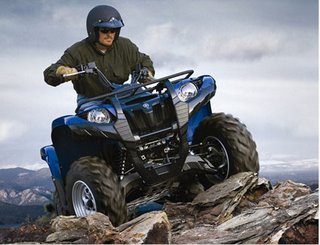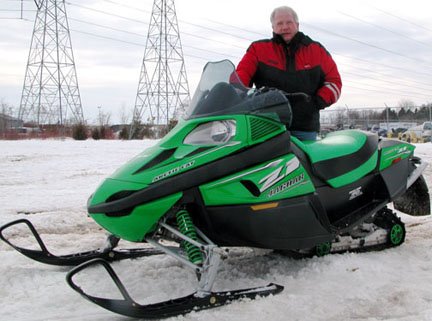
Yamaha Snocrosser
Test Bed For Future
While not saying in so many words, Yamaha race team spokesmen acknowledge that what you see on the snocross tracks this year will most likely find its way into future new model Yamaha sleds.
The purpose of the snocross team is to prove that Yamaha 4strokes can compete in the tough big bump race circuit. For Yamaha the “big bump” rider is as yet an untapped growth area for sales. Reaching and convincing that younger, aggressive terrain rider that Yamaha snowmobiles are suited to their needs has been part of Yamaha product planning’s current 5-year program.
“We’ve been racing in Europe and Japan with 4strokes for the past three seasons,” stated Yamaha US race team manager, Greg Marier. “We have a well thought-out plan to capture consumers with big bump interest. These are the riders who like to fly, jump and ride in aggressive bumps.”
R&D Racing —Yamaha’s Research and Development racing crew is adding its own stamp to the product plan as racing abets standard Yamaha test programs for its trail sleds. Think of Yamaha R&D racing as an accelerated portion of standard testing for trail sleds.

If you look at the current Phazer-based snocrosser, you’ll note that many components are designed for engineering flexibility. The engine location can be modified. The racer’s physical seating position can be modified. And, of course, Yamaha is continually testing concepts in suspension design to find the right blend of front and rear setup for big bump and trail riding needs.
Like Yamaha’s last snocrosser, which ended its run with the ’03 season, the current design uses a modified Vector-based, triple-cylinder engine. Existing 4stroke engine rules specify an inline triple with no gear reduction and a maximum displacement of 1050cc.
Yamaha acknowledges that it is not the lightest racer in modified snocross competition. But R&D feels that snocross competition accelerates the learning curve, as Yamaha has to face down tough competition on the racetrack.
Focal Points —Marier noted that the R&D race team is focused on three main areas with its existing design: determining the best “rider forward” ergonomics for big bump terrain riding; maximizing power delivery; and, determining the best suspension setups.
 For the big bump rider, power delivery is more than sheer horsepower and top speed. Figure that Yamaha is working to maximize torque (out of the hole, off the bump and out of the corner acceleration) while maintaining as much top end straightaway speed as it can. For those of you familiar with Polaris’ TX-L cross country sleds of the 1970s, its 333cc twin was not the most powerful engine of its day. It was the most successful as it won more long distance terrain races than any other model—by any non-Polaris manufacturer! Yamaha hopes to achieve that blend of competence with its next generation “big bump” sled.
For the big bump rider, power delivery is more than sheer horsepower and top speed. Figure that Yamaha is working to maximize torque (out of the hole, off the bump and out of the corner acceleration) while maintaining as much top end straightaway speed as it can. For those of you familiar with Polaris’ TX-L cross country sleds of the 1970s, its 333cc twin was not the most powerful engine of its day. It was the most successful as it won more long distance terrain races than any other model—by any non-Polaris manufacturer! Yamaha hopes to achieve that blend of competence with its next generation “big bump” sled.To date, Yamaha has done extremely well with its 4stroke models. In some cases the Japanese-based manufacturer has gained upwards of 50 percent market share in certain segments. But big bump riding is not one of the bright spots. Yamaha feels that those riders are important and wants to reach them with a dominant snowmobile that is nimble, flies well and handles the big moguls as well as, if not better than, the competition.
Our Opinion —If we were looking to the future, we would not become enamored with the current Vector triple as the power source for a new breed of mogul master sled from Yamaha. While it is great for trail sleds, it may be too heavy for a future “big bump” Yamaha. The current Phazer twin has gear reduction and is fairly well tapped for power in its current guise. Rule it out for the future mogul master.
No, we’d look for a new inline triple design that is lighter, as torquey as the Vector triple, delivering 110-plus horsepower, and using fewer, but bigger valves to breathe in and out. Look for a revamped drive system, most likely evolutionary, that will be extremely quick to respond both on and off the throttle. And expect pinpoint throttle response from digitally programmed fuel injection.
 More Opinion —As for the suspension, for now Yamaha seems convinced that a torsion-sprung rear unit is the best way to go. But expect some major rethinking there—in the longer-term future. We are unconvinced that current Yamaha torsion-spring rear designs are the answer, no matter how evolved they become. Yamaha needs to totally revisit suspension design—front and rear—as this is holding them back. The front end uses very long arms for extended “big bump” action. It uses it on the Phazer and a variation on the previous snocrosser, too.
More Opinion —As for the suspension, for now Yamaha seems convinced that a torsion-sprung rear unit is the best way to go. But expect some major rethinking there—in the longer-term future. We are unconvinced that current Yamaha torsion-spring rear designs are the answer, no matter how evolved they become. Yamaha needs to totally revisit suspension design—front and rear—as this is holding them back. The front end uses very long arms for extended “big bump” action. It uses it on the Phazer and a variation on the previous snocrosser, too.Yamaha is also discovering something that other manufacturers learned the hard way—weight creates problems. You can lighten up a trail sled, but when you lighten a race sled, you find durability suffers. Note the obvious bracing on the Phazer-based snocrosser. That adds to weight. And what is necessary is a new sheet of paper to come up with a new design. We suspect that is what we’ll see in the future. A sled built tough where necessary, but lighter where R&D racing discovers it’s unnecessary. This is what R&D racing contributes.
For Now —Will Yamaha reach its goal? We won’t bet against it. Speed and high performance trail handling? The Apex has it. Lightweight, moderate priced 4stroke performance and economy? There’s the Phazer series. Everyday trail riding for the high mileage rider? Vector and its next iteration take care of that. Big bump riding satisfaction from a 4stroke? Yamaha is trying with the Phazer FX and Nytro styled machines, but they aren’t there yet. What you are seeing in the R&D racing snocrossers provides hints of the future. It’s yet to come to Yamaha dealer showrooms. But, inevitably, it’s going to come! You can count on that. When it does, the competition better have been preparing.
© 2006 Snowmobilia/Jerry Bassett
To comment go to –
http://www.amsnow.com/jerrysblog











 The 6x6 or 8x8 ARGO models seat up to six passengers. Other applications include hunting, fishing and bush trekking through mud, across water and over snow. More and more commercial users in the utility, natural resource and public sectors rely on the ARGO in the toughest off-road conditions, all year round.ODG has developed a wide range of options offering greater comfort, protection and convenience.
The 6x6 or 8x8 ARGO models seat up to six passengers. Other applications include hunting, fishing and bush trekking through mud, across water and over snow. More and more commercial users in the utility, natural resource and public sectors rely on the ARGO in the toughest off-road conditions, all year round.ODG has developed a wide range of options offering greater comfort, protection and convenience.


























